Commercial Law Assignment: Performance Bonds and Consumer Rights
VerifiedAdded on 2023/06/10
|7
|1907
|421
Report
AI Summary
This commercial law assignment addresses three key areas. Firstly, it critically examines the circumstances under which payment can be withheld in relation to performance bonds, detailing the nature of these bonds, the concept of secondary liability, and the implications of breach of contract. Secondly, it advises A Ltd on whether they are bound by a contract with B, considering the powers of company directors, delegation of authority, and the Companies Act's provisions on good faith. Finally, the assignment critically discusses the changes introduced by the Consumer Rights Act 2015 concerning the supply of goods, digital content, and services to consumers. It outlines the Act's three-tier structure, digital content regulations, and the cooling-off period, providing a comprehensive overview of the legal landscape affecting consumer transactions. The report incorporates relevant legislation and examples to support its analysis, providing insights into commercial law principles and their practical application. The assignment demonstrates an understanding of contract law, consumer rights, and the legal responsibilities of businesses.
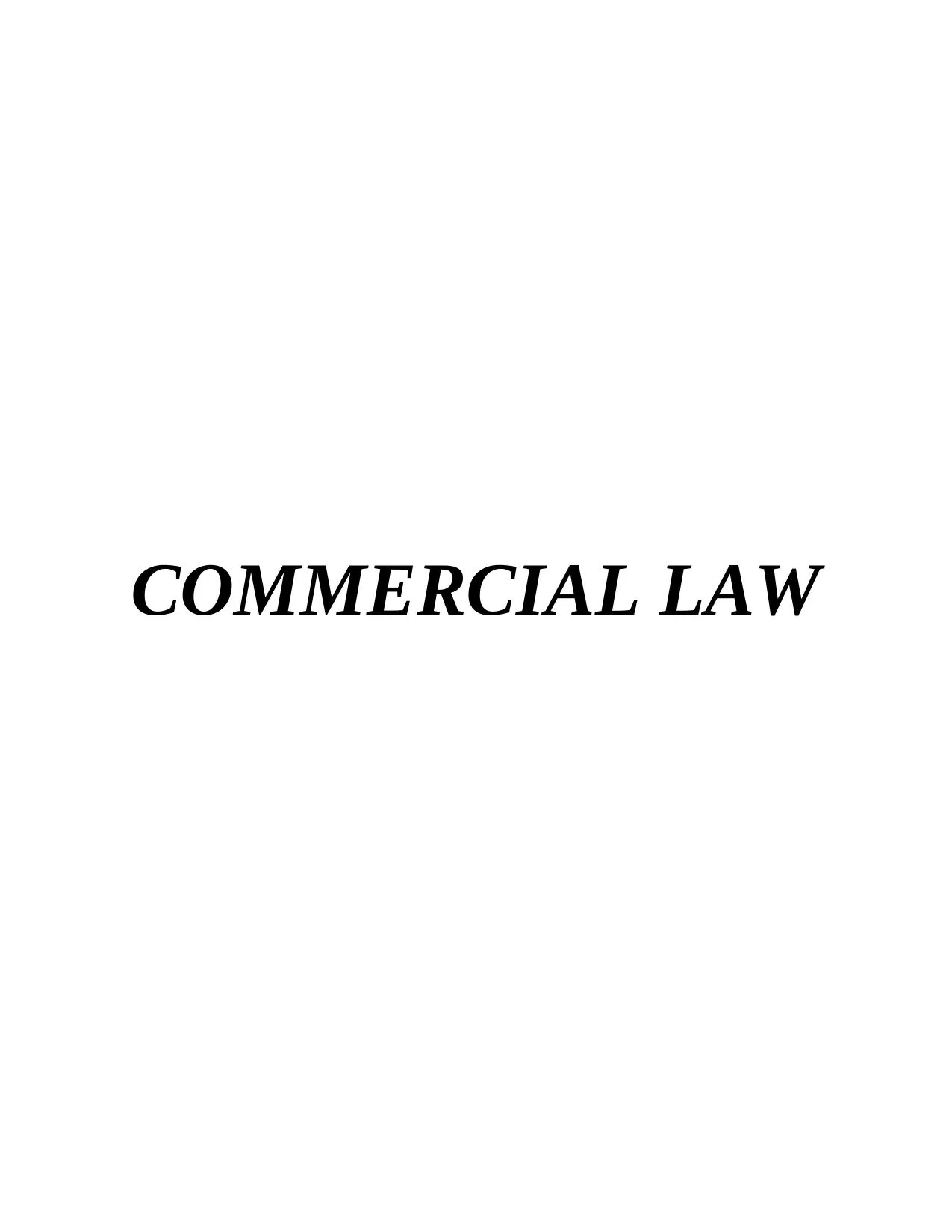
COMMERCIAL LAW
Paraphrase This Document
Need a fresh take? Get an instant paraphrase of this document with our AI Paraphraser
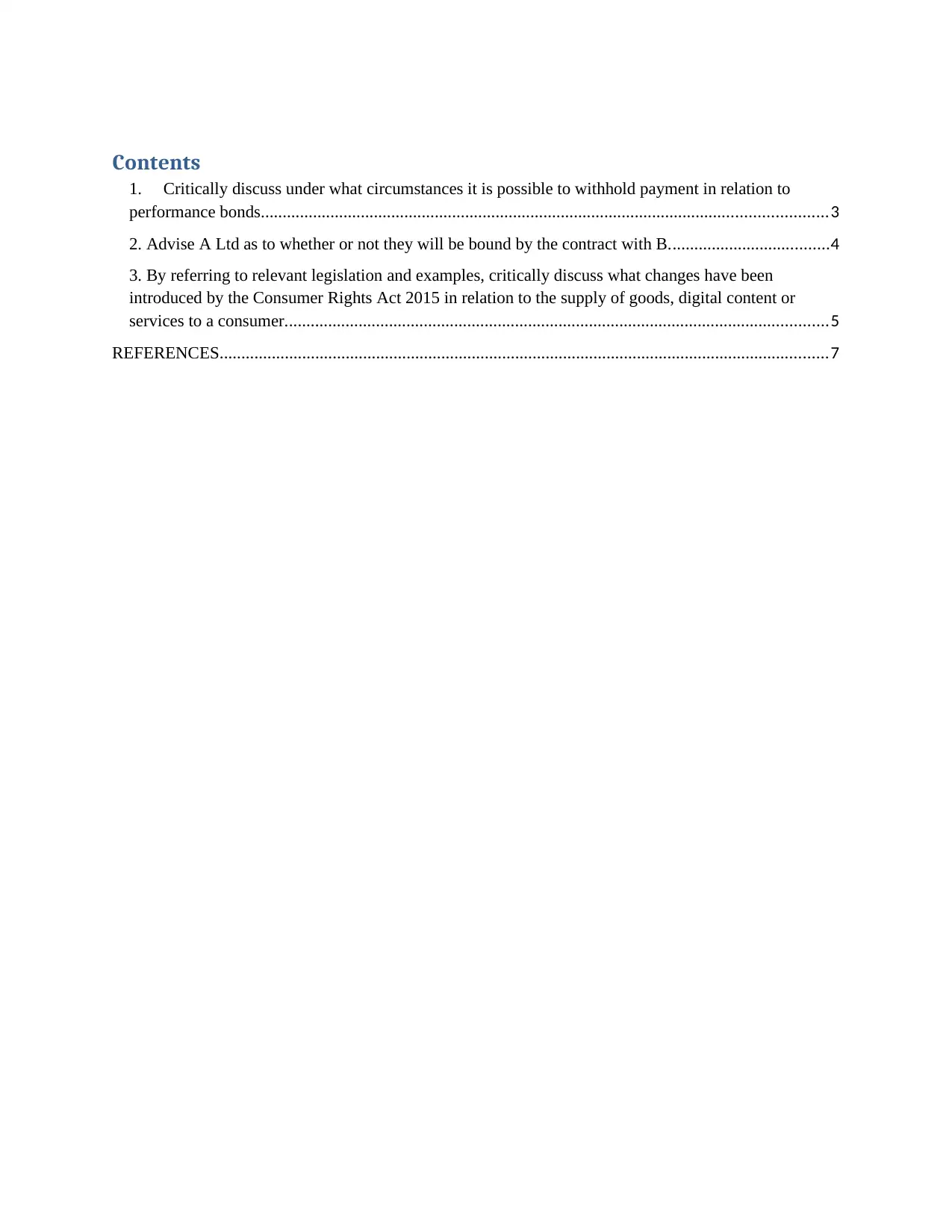
Contents
1. Critically discuss under what circumstances it is possible to withhold payment in relation to
performance bonds..................................................................................................................................3
2. Advise A Ltd as to whether or not they will be bound by the contract with B.....................................4
3. By referring to relevant legislation and examples, critically discuss what changes have been
introduced by the Consumer Rights Act 2015 in relation to the supply of goods, digital content or
services to a consumer.............................................................................................................................5
REFERENCES............................................................................................................................................7
1. Critically discuss under what circumstances it is possible to withhold payment in relation to
performance bonds..................................................................................................................................3
2. Advise A Ltd as to whether or not they will be bound by the contract with B.....................................4
3. By referring to relevant legislation and examples, critically discuss what changes have been
introduced by the Consumer Rights Act 2015 in relation to the supply of goods, digital content or
services to a consumer.............................................................................................................................5
REFERENCES............................................................................................................................................7
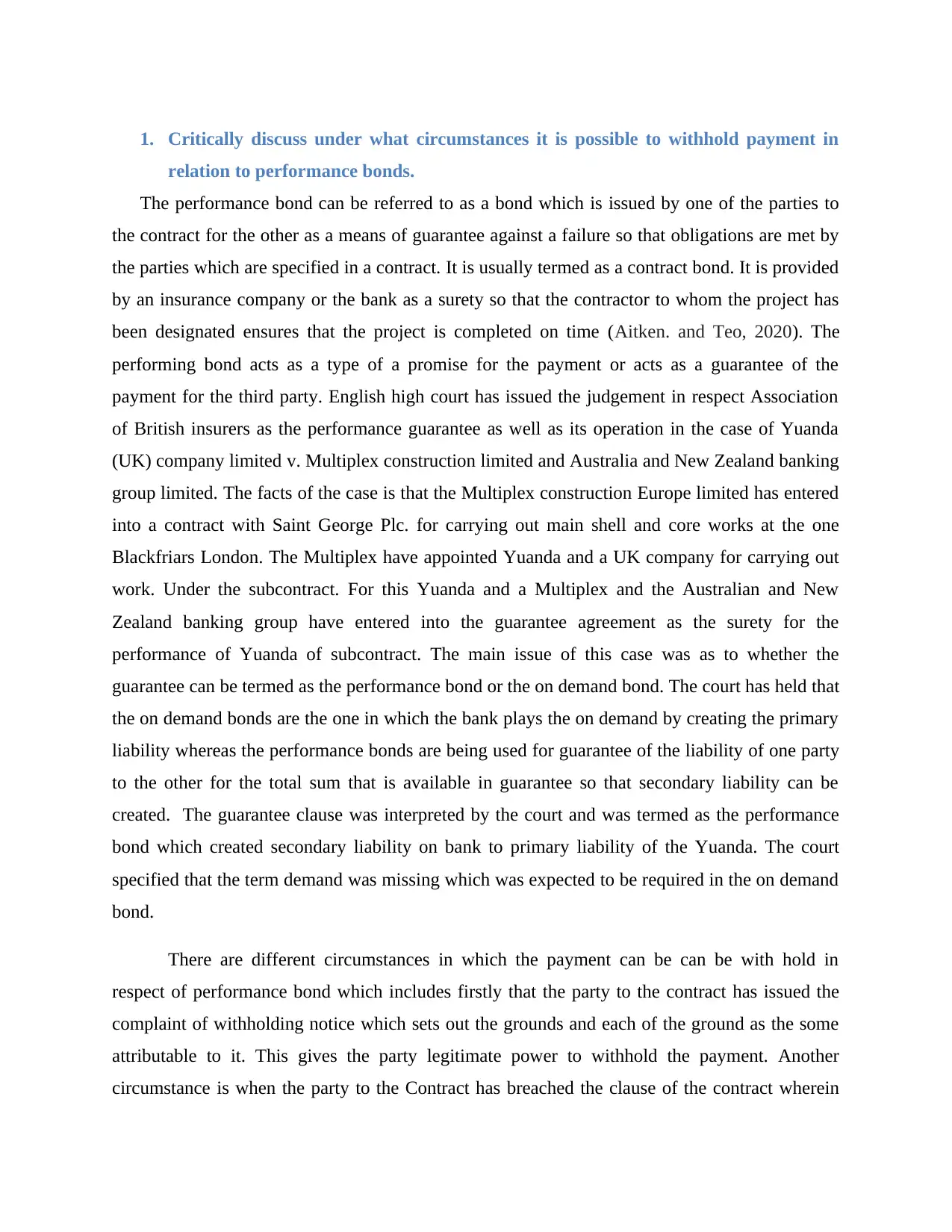
1. Critically discuss under what circumstances it is possible to withhold payment in
relation to performance bonds.
The performance bond can be referred to as a bond which is issued by one of the parties to
the contract for the other as a means of guarantee against a failure so that obligations are met by
the parties which are specified in a contract. It is usually termed as a contract bond. It is provided
by an insurance company or the bank as a surety so that the contractor to whom the project has
been designated ensures that the project is completed on time (Aitken. and Teo, 2020). The
performing bond acts as a type of a promise for the payment or acts as a guarantee of the
payment for the third party. English high court has issued the judgement in respect Association
of British insurers as the performance guarantee as well as its operation in the case of Yuanda
(UK) company limited v. Multiplex construction limited and Australia and New Zealand banking
group limited. The facts of the case is that the Multiplex construction Europe limited has entered
into a contract with Saint George Plc. for carrying out main shell and core works at the one
Blackfriars London. The Multiplex have appointed Yuanda and a UK company for carrying out
work. Under the subcontract. For this Yuanda and a Multiplex and the Australian and New
Zealand banking group have entered into the guarantee agreement as the surety for the
performance of Yuanda of subcontract. The main issue of this case was as to whether the
guarantee can be termed as the performance bond or the on demand bond. The court has held that
the on demand bonds are the one in which the bank plays the on demand by creating the primary
liability whereas the performance bonds are being used for guarantee of the liability of one party
to the other for the total sum that is available in guarantee so that secondary liability can be
created. The guarantee clause was interpreted by the court and was termed as the performance
bond which created secondary liability on bank to primary liability of the Yuanda. The court
specified that the term demand was missing which was expected to be required in the on demand
bond.
There are different circumstances in which the payment can be can be with hold in
respect of performance bond which includes firstly that the party to the contract has issued the
complaint of withholding notice which sets out the grounds and each of the ground as the some
attributable to it. This gives the party legitimate power to withhold the payment. Another
circumstance is when the party to the Contract has breached the clause of the contract wherein
relation to performance bonds.
The performance bond can be referred to as a bond which is issued by one of the parties to
the contract for the other as a means of guarantee against a failure so that obligations are met by
the parties which are specified in a contract. It is usually termed as a contract bond. It is provided
by an insurance company or the bank as a surety so that the contractor to whom the project has
been designated ensures that the project is completed on time (Aitken. and Teo, 2020). The
performing bond acts as a type of a promise for the payment or acts as a guarantee of the
payment for the third party. English high court has issued the judgement in respect Association
of British insurers as the performance guarantee as well as its operation in the case of Yuanda
(UK) company limited v. Multiplex construction limited and Australia and New Zealand banking
group limited. The facts of the case is that the Multiplex construction Europe limited has entered
into a contract with Saint George Plc. for carrying out main shell and core works at the one
Blackfriars London. The Multiplex have appointed Yuanda and a UK company for carrying out
work. Under the subcontract. For this Yuanda and a Multiplex and the Australian and New
Zealand banking group have entered into the guarantee agreement as the surety for the
performance of Yuanda of subcontract. The main issue of this case was as to whether the
guarantee can be termed as the performance bond or the on demand bond. The court has held that
the on demand bonds are the one in which the bank plays the on demand by creating the primary
liability whereas the performance bonds are being used for guarantee of the liability of one party
to the other for the total sum that is available in guarantee so that secondary liability can be
created. The guarantee clause was interpreted by the court and was termed as the performance
bond which created secondary liability on bank to primary liability of the Yuanda. The court
specified that the term demand was missing which was expected to be required in the on demand
bond.
There are different circumstances in which the payment can be can be with hold in
respect of performance bond which includes firstly that the party to the contract has issued the
complaint of withholding notice which sets out the grounds and each of the ground as the some
attributable to it. This gives the party legitimate power to withhold the payment. Another
circumstance is when the party to the Contract has breached the clause of the contract wherein
⊘ This is a preview!⊘
Do you want full access?
Subscribe today to unlock all pages.

Trusted by 1+ million students worldwide
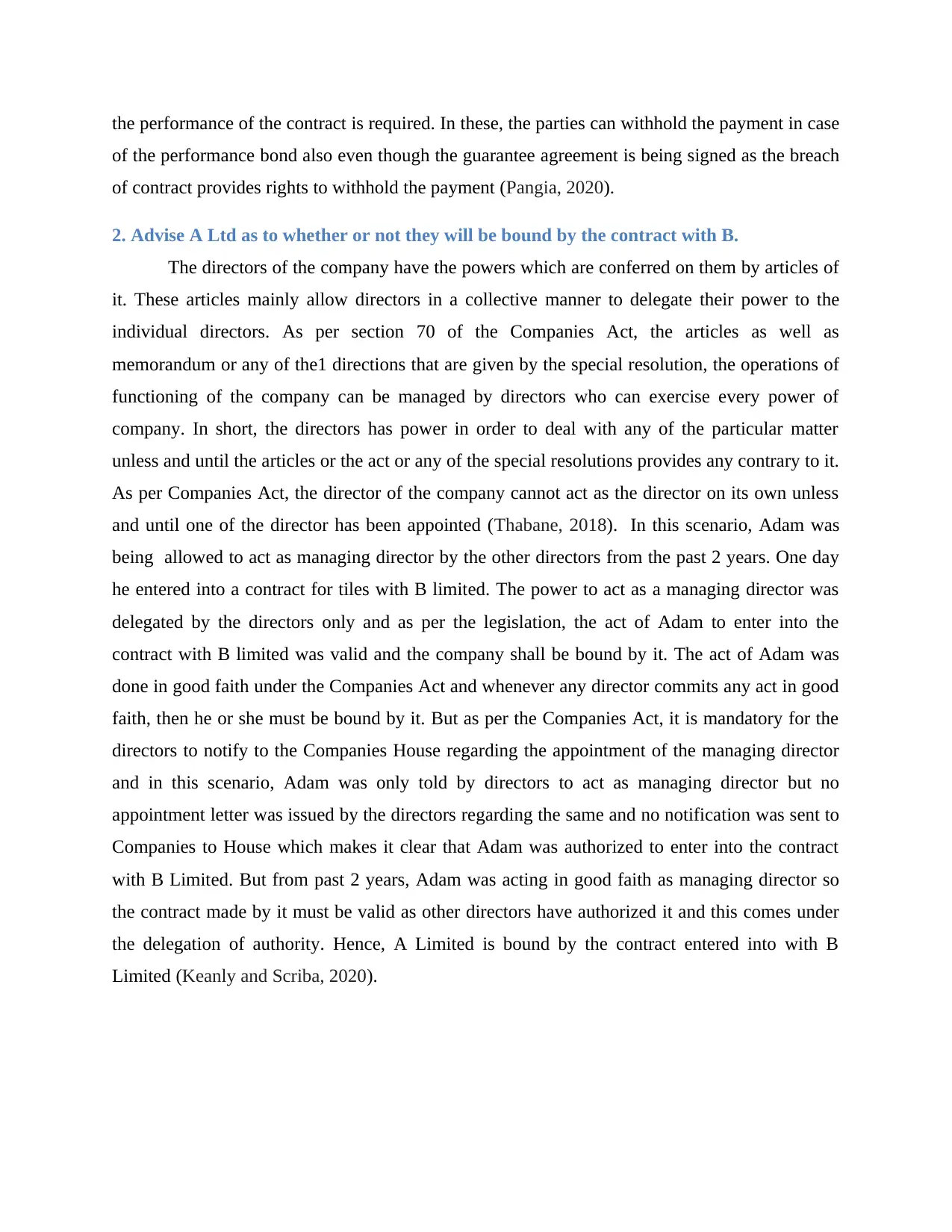
the performance of the contract is required. In these, the parties can withhold the payment in case
of the performance bond also even though the guarantee agreement is being signed as the breach
of contract provides rights to withhold the payment (Pangia, 2020).
2. Advise A Ltd as to whether or not they will be bound by the contract with B.
The directors of the company have the powers which are conferred on them by articles of
it. These articles mainly allow directors in a collective manner to delegate their power to the
individual directors. As per section 70 of the Companies Act, the articles as well as
memorandum or any of the1 directions that are given by the special resolution, the operations of
functioning of the company can be managed by directors who can exercise every power of
company. In short, the directors has power in order to deal with any of the particular matter
unless and until the articles or the act or any of the special resolutions provides any contrary to it.
As per Companies Act, the director of the company cannot act as the director on its own unless
and until one of the director has been appointed (Thabane, 2018). In this scenario, Adam was
being allowed to act as managing director by the other directors from the past 2 years. One day
he entered into a contract for tiles with B limited. The power to act as a managing director was
delegated by the directors only and as per the legislation, the act of Adam to enter into the
contract with B limited was valid and the company shall be bound by it. The act of Adam was
done in good faith under the Companies Act and whenever any director commits any act in good
faith, then he or she must be bound by it. But as per the Companies Act, it is mandatory for the
directors to notify to the Companies House regarding the appointment of the managing director
and in this scenario, Adam was only told by directors to act as managing director but no
appointment letter was issued by the directors regarding the same and no notification was sent to
Companies to House which makes it clear that Adam was authorized to enter into the contract
with B Limited. But from past 2 years, Adam was acting in good faith as managing director so
the contract made by it must be valid as other directors have authorized it and this comes under
the delegation of authority. Hence, A Limited is bound by the contract entered into with B
Limited (Keanly and Scriba, 2020).
of the performance bond also even though the guarantee agreement is being signed as the breach
of contract provides rights to withhold the payment (Pangia, 2020).
2. Advise A Ltd as to whether or not they will be bound by the contract with B.
The directors of the company have the powers which are conferred on them by articles of
it. These articles mainly allow directors in a collective manner to delegate their power to the
individual directors. As per section 70 of the Companies Act, the articles as well as
memorandum or any of the1 directions that are given by the special resolution, the operations of
functioning of the company can be managed by directors who can exercise every power of
company. In short, the directors has power in order to deal with any of the particular matter
unless and until the articles or the act or any of the special resolutions provides any contrary to it.
As per Companies Act, the director of the company cannot act as the director on its own unless
and until one of the director has been appointed (Thabane, 2018). In this scenario, Adam was
being allowed to act as managing director by the other directors from the past 2 years. One day
he entered into a contract for tiles with B limited. The power to act as a managing director was
delegated by the directors only and as per the legislation, the act of Adam to enter into the
contract with B limited was valid and the company shall be bound by it. The act of Adam was
done in good faith under the Companies Act and whenever any director commits any act in good
faith, then he or she must be bound by it. But as per the Companies Act, it is mandatory for the
directors to notify to the Companies House regarding the appointment of the managing director
and in this scenario, Adam was only told by directors to act as managing director but no
appointment letter was issued by the directors regarding the same and no notification was sent to
Companies to House which makes it clear that Adam was authorized to enter into the contract
with B Limited. But from past 2 years, Adam was acting in good faith as managing director so
the contract made by it must be valid as other directors have authorized it and this comes under
the delegation of authority. Hence, A Limited is bound by the contract entered into with B
Limited (Keanly and Scriba, 2020).
Paraphrase This Document
Need a fresh take? Get an instant paraphrase of this document with our AI Paraphraser
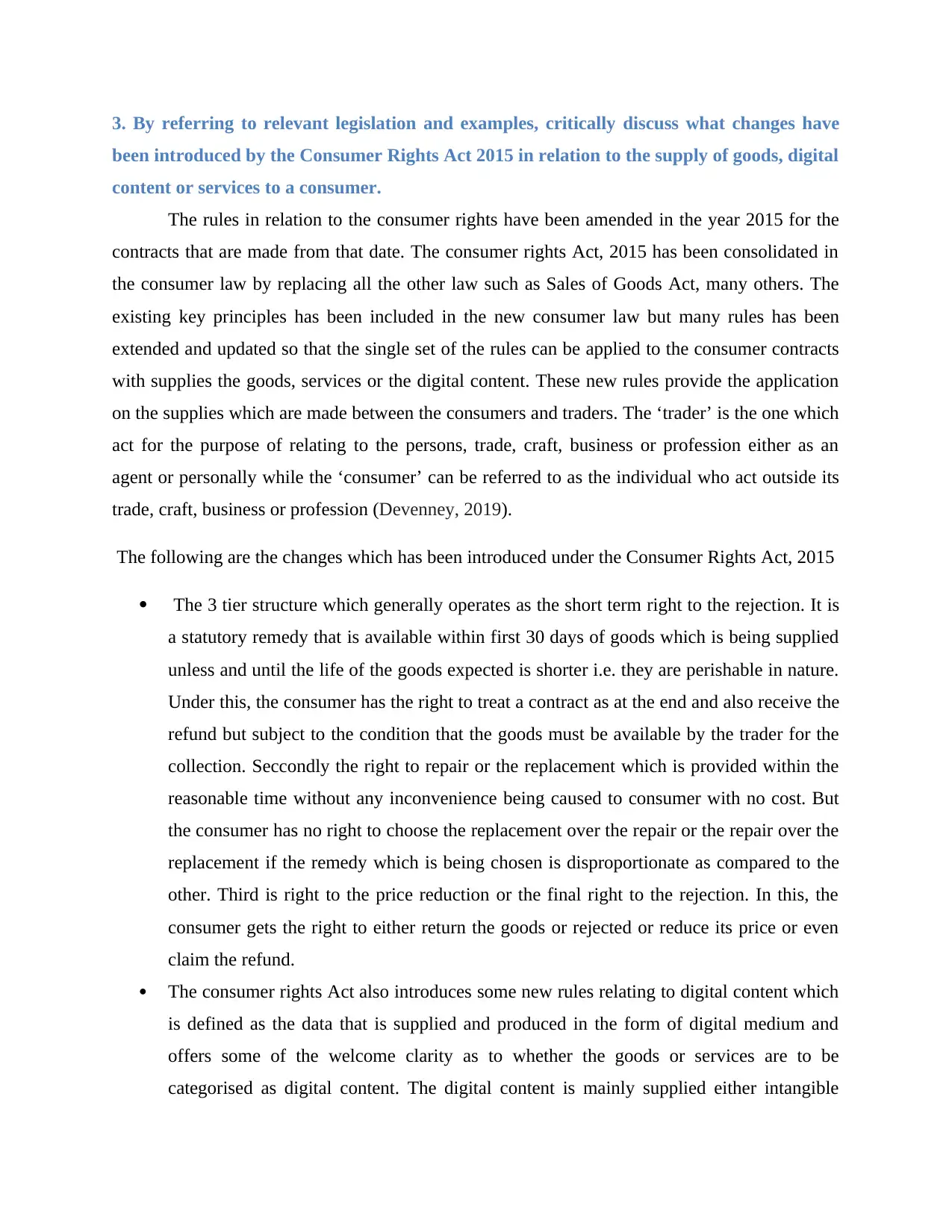
3. By referring to relevant legislation and examples, critically discuss what changes have
been introduced by the Consumer Rights Act 2015 in relation to the supply of goods, digital
content or services to a consumer.
The rules in relation to the consumer rights have been amended in the year 2015 for the
contracts that are made from that date. The consumer rights Act, 2015 has been consolidated in
the consumer law by replacing all the other law such as Sales of Goods Act, many others. The
existing key principles has been included in the new consumer law but many rules has been
extended and updated so that the single set of the rules can be applied to the consumer contracts
with supplies the goods, services or the digital content. These new rules provide the application
on the supplies which are made between the consumers and traders. The ‘trader’ is the one which
act for the purpose of relating to the persons, trade, craft, business or profession either as an
agent or personally while the ‘consumer’ can be referred to as the individual who act outside its
trade, craft, business or profession (Devenney, 2019).
The following are the changes which has been introduced under the Consumer Rights Act, 2015
The 3 tier structure which generally operates as the short term right to the rejection. It is
a statutory remedy that is available within first 30 days of goods which is being supplied
unless and until the life of the goods expected is shorter i.e. they are perishable in nature.
Under this, the consumer has the right to treat a contract as at the end and also receive the
refund but subject to the condition that the goods must be available by the trader for the
collection. Seccondly the right to repair or the replacement which is provided within the
reasonable time without any inconvenience being caused to consumer with no cost. But
the consumer has no right to choose the replacement over the repair or the repair over the
replacement if the remedy which is being chosen is disproportionate as compared to the
other. Third is right to the price reduction or the final right to the rejection. In this, the
consumer gets the right to either return the goods or rejected or reduce its price or even
claim the refund.
The consumer rights Act also introduces some new rules relating to digital content which
is defined as the data that is supplied and produced in the form of digital medium and
offers some of the welcome clarity as to whether the goods or services are to be
categorised as digital content. The digital content is mainly supplied either intangible
been introduced by the Consumer Rights Act 2015 in relation to the supply of goods, digital
content or services to a consumer.
The rules in relation to the consumer rights have been amended in the year 2015 for the
contracts that are made from that date. The consumer rights Act, 2015 has been consolidated in
the consumer law by replacing all the other law such as Sales of Goods Act, many others. The
existing key principles has been included in the new consumer law but many rules has been
extended and updated so that the single set of the rules can be applied to the consumer contracts
with supplies the goods, services or the digital content. These new rules provide the application
on the supplies which are made between the consumers and traders. The ‘trader’ is the one which
act for the purpose of relating to the persons, trade, craft, business or profession either as an
agent or personally while the ‘consumer’ can be referred to as the individual who act outside its
trade, craft, business or profession (Devenney, 2019).
The following are the changes which has been introduced under the Consumer Rights Act, 2015
The 3 tier structure which generally operates as the short term right to the rejection. It is
a statutory remedy that is available within first 30 days of goods which is being supplied
unless and until the life of the goods expected is shorter i.e. they are perishable in nature.
Under this, the consumer has the right to treat a contract as at the end and also receive the
refund but subject to the condition that the goods must be available by the trader for the
collection. Seccondly the right to repair or the replacement which is provided within the
reasonable time without any inconvenience being caused to consumer with no cost. But
the consumer has no right to choose the replacement over the repair or the repair over the
replacement if the remedy which is being chosen is disproportionate as compared to the
other. Third is right to the price reduction or the final right to the rejection. In this, the
consumer gets the right to either return the goods or rejected or reduce its price or even
claim the refund.
The consumer rights Act also introduces some new rules relating to digital content which
is defined as the data that is supplied and produced in the form of digital medium and
offers some of the welcome clarity as to whether the goods or services are to be
categorised as digital content. The digital content is mainly supplied either intangible
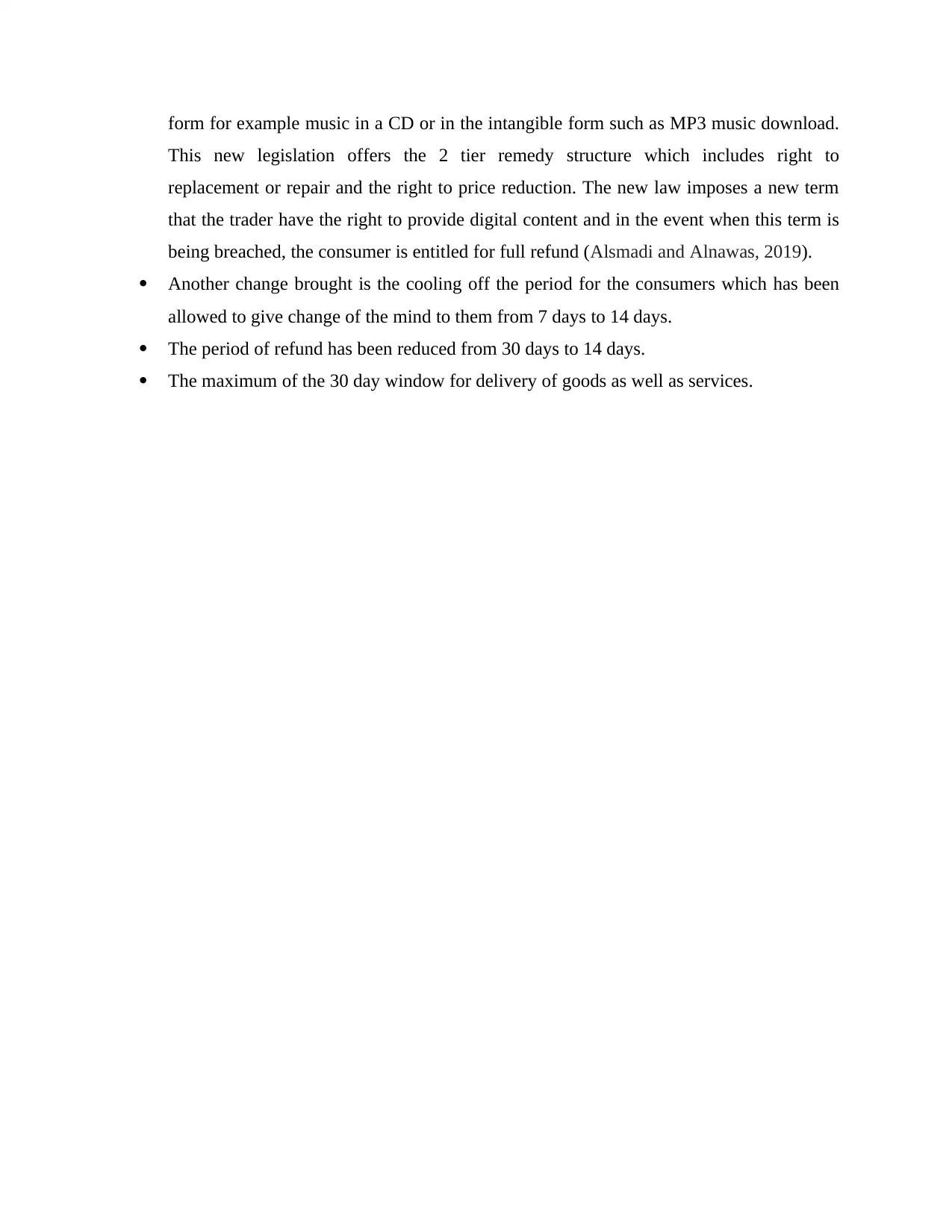
form for example music in a CD or in the intangible form such as MP3 music download.
This new legislation offers the 2 tier remedy structure which includes right to
replacement or repair and the right to price reduction. The new law imposes a new term
that the trader have the right to provide digital content and in the event when this term is
being breached, the consumer is entitled for full refund (Alsmadi and Alnawas, 2019).
Another change brought is the cooling off the period for the consumers which has been
allowed to give change of the mind to them from 7 days to 14 days.
The period of refund has been reduced from 30 days to 14 days.
The maximum of the 30 day window for delivery of goods as well as services.
This new legislation offers the 2 tier remedy structure which includes right to
replacement or repair and the right to price reduction. The new law imposes a new term
that the trader have the right to provide digital content and in the event when this term is
being breached, the consumer is entitled for full refund (Alsmadi and Alnawas, 2019).
Another change brought is the cooling off the period for the consumers which has been
allowed to give change of the mind to them from 7 days to 14 days.
The period of refund has been reduced from 30 days to 14 days.
The maximum of the 30 day window for delivery of goods as well as services.
⊘ This is a preview!⊘
Do you want full access?
Subscribe today to unlock all pages.

Trusted by 1+ million students worldwide
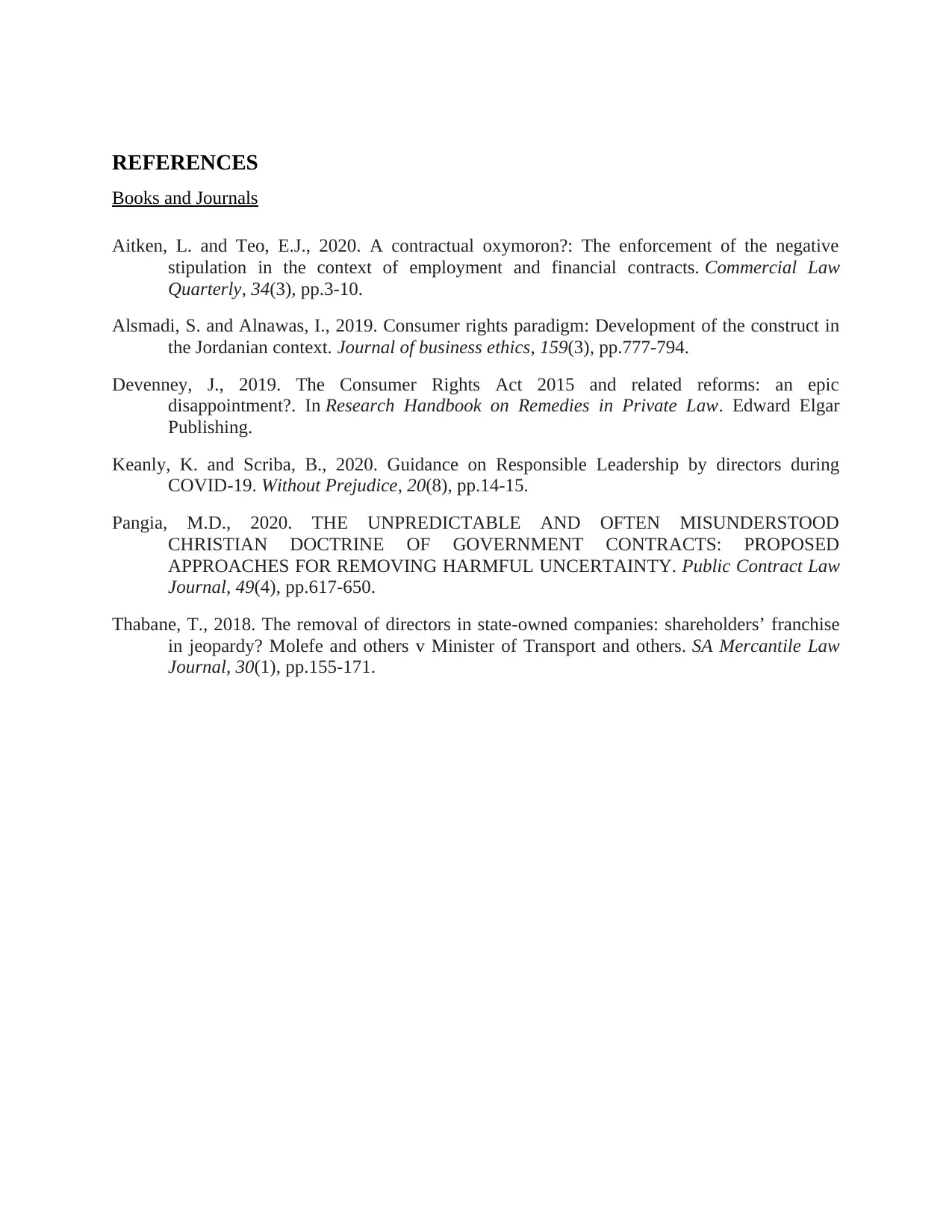
REFERENCES
Books and Journals
Aitken, L. and Teo, E.J., 2020. A contractual oxymoron?: The enforcement of the negative
stipulation in the context of employment and financial contracts. Commercial Law
Quarterly, 34(3), pp.3-10.
Alsmadi, S. and Alnawas, I., 2019. Consumer rights paradigm: Development of the construct in
the Jordanian context. Journal of business ethics, 159(3), pp.777-794.
Devenney, J., 2019. The Consumer Rights Act 2015 and related reforms: an epic
disappointment?. In Research Handbook on Remedies in Private Law. Edward Elgar
Publishing.
Keanly, K. and Scriba, B., 2020. Guidance on Responsible Leadership by directors during
COVID-19. Without Prejudice, 20(8), pp.14-15.
Pangia, M.D., 2020. THE UNPREDICTABLE AND OFTEN MISUNDERSTOOD
CHRISTIAN DOCTRINE OF GOVERNMENT CONTRACTS: PROPOSED
APPROACHES FOR REMOVING HARMFUL UNCERTAINTY. Public Contract Law
Journal, 49(4), pp.617-650.
Thabane, T., 2018. The removal of directors in state-owned companies: shareholders’ franchise
in jeopardy? Molefe and others v Minister of Transport and others. SA Mercantile Law
Journal, 30(1), pp.155-171.
Books and Journals
Aitken, L. and Teo, E.J., 2020. A contractual oxymoron?: The enforcement of the negative
stipulation in the context of employment and financial contracts. Commercial Law
Quarterly, 34(3), pp.3-10.
Alsmadi, S. and Alnawas, I., 2019. Consumer rights paradigm: Development of the construct in
the Jordanian context. Journal of business ethics, 159(3), pp.777-794.
Devenney, J., 2019. The Consumer Rights Act 2015 and related reforms: an epic
disappointment?. In Research Handbook on Remedies in Private Law. Edward Elgar
Publishing.
Keanly, K. and Scriba, B., 2020. Guidance on Responsible Leadership by directors during
COVID-19. Without Prejudice, 20(8), pp.14-15.
Pangia, M.D., 2020. THE UNPREDICTABLE AND OFTEN MISUNDERSTOOD
CHRISTIAN DOCTRINE OF GOVERNMENT CONTRACTS: PROPOSED
APPROACHES FOR REMOVING HARMFUL UNCERTAINTY. Public Contract Law
Journal, 49(4), pp.617-650.
Thabane, T., 2018. The removal of directors in state-owned companies: shareholders’ franchise
in jeopardy? Molefe and others v Minister of Transport and others. SA Mercantile Law
Journal, 30(1), pp.155-171.
1 out of 7
Related Documents
Your All-in-One AI-Powered Toolkit for Academic Success.
+13062052269
info@desklib.com
Available 24*7 on WhatsApp / Email
![[object Object]](/_next/static/media/star-bottom.7253800d.svg)
Unlock your academic potential
Copyright © 2020–2025 A2Z Services. All Rights Reserved. Developed and managed by ZUCOL.





